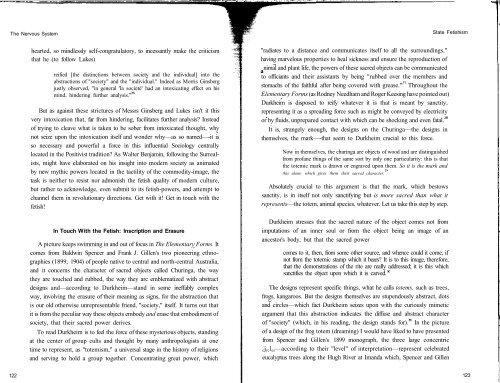The Nervous System - Department of English and Comparative ...
The Nervous System - Department of English and Comparative ...
The Nervous System - Department of English and Comparative ...
Create successful ePaper yourself
Turn your PDF publications into a flip-book with our unique Google optimized e-Paper software.
<strong>The</strong> <strong>Nervous</strong> <strong>System</strong><br />
State Fetishism<br />
hearted, so mindlessly self-congratulatory, to incessantly make the criticism<br />
that he (to follow Lukes)<br />
reified [the distinctions between society <strong>and</strong> the individual] into the<br />
abstractions <strong>of</strong> "society" <strong>and</strong> the "individual." Indeed as Morris Ginsberg<br />
justly observed, "in general 'la societe' had an intoxicating effect on his<br />
mind, hindering further analysis."<br />
But as against these strictures <strong>of</strong> Messrs Ginsberg <strong>and</strong> Lukes isn't it this<br />
very intoxication that, far from hindering, facilitates further analysis? Instead<br />
<strong>of</strong> trying to cleave what is taken to be sober from intoxicated thought, why<br />
not seize upon the intoxication itself <strong>and</strong> wonder why—as so named—-it is<br />
so necessary <strong>and</strong> powerful a force in this influential Sociology centrally<br />
located in the Positivist tradition? As Walter Benjamin, following the Surrealists,<br />
might have elaborated on his insight into modern society as animated<br />
by new mythic powers located in the tactility <strong>of</strong> the commodity-image, the<br />
task is neither to resist nor admonish the fetish quality <strong>of</strong> modern culture,<br />
but rather to acknowledge, even submit to its fetish-powers, <strong>and</strong> attempt to<br />
channel them in revolutionary directions. Get with it! Get in touch with the<br />
fetish!<br />
In Touch With the Fetish: Inscription <strong>and</strong> Erasure<br />
A picture keeps swimming in <strong>and</strong> out <strong>of</strong> focus in <strong>The</strong> Elementary Forms. It<br />
comes from Baldwin Spencer <strong>and</strong> Frank J. Gillen's two pioneering ethnographies<br />
(1899, 1904) <strong>of</strong> people native to central <strong>and</strong> north-central Australia,<br />
<strong>and</strong> it concerns the character <strong>of</strong> sacred objects called Churinga, the way<br />
they are touched <strong>and</strong> rubbed, the way they arc emblematized with abstract<br />
designs <strong>and</strong>—according to Durkheim—st<strong>and</strong> in some ineffably complex<br />
way, involving the erasure <strong>of</strong> their meaning as signs, for the abstraction that<br />
is our old otherwise unrepresentable friend, "society," itself. It turns out that<br />
it is from the peculiar way these objects embody <strong>and</strong> erase that embodiment <strong>of</strong><br />
society, that their sacred power derives.<br />
To read Durkheim is to feel the force <strong>of</strong> these mysterious objects, st<strong>and</strong>ing<br />
at the center <strong>of</strong> group cults <strong>and</strong> thought by many anthropologists at one<br />
time to represent, as "totemism," a universal stage in the history <strong>of</strong> religions<br />
<strong>and</strong> serving to hold a group together. Concentrating great power, which<br />
"radiates to a distance <strong>and</strong> communicates itself to all the surroundings,"<br />
having marvelous properties to heal sickness <strong>and</strong> ensure the reproduction <strong>of</strong><br />
nimal <strong>and</strong> plant life, the powers <strong>of</strong> these sacred objects can be communicated<br />
to <strong>of</strong>ficiants <strong>and</strong> their assistants by being "rubbed over the members <strong>and</strong><br />
stomachs <strong>of</strong> the faithful after being covered with grease." Throughout the<br />
Elementary Forms (as Rodney Needham <strong>and</strong> Roger Keesing have pointed out)<br />
Durkheim is disposed to reify whatever it is that is meant by sanctity,<br />
representing it as a spreading force such as might be conveyed by electricity<br />
or by fluids, unprepared contact with which can be shocking <strong>and</strong> even fatal.<br />
It is, strangely enough, the designs on the Churinga—the designs in<br />
themselves, the mark—-that seem to Durkheim crucial to this force.<br />
Now in themselves, the churinga are objects <strong>of</strong> wood <strong>and</strong> are distinguished<br />
from pr<strong>of</strong>ane things <strong>of</strong> the same sort by only one particularity: this is that<br />
the totemic mark is drawn or engraved upon them. So it is the mark <strong>and</strong><br />
this alone which gives them their sacred character.<br />
Absolutely crucial to this argument is that the mark, which bestows<br />
sanctity, is in itself not only sanctifying but is more sacred than what it<br />
represents—the totem, animal species, whatever. Let us take this step by step.<br />
Durkheim stresses that the sacred nature <strong>of</strong> the object comes not from<br />
imputations <strong>of</strong> an inner soul or from the object being an image <strong>of</strong> an<br />
ancestor's body, but that the sacred power<br />
comes to it, then, from some other source, <strong>and</strong> whence could it come, if<br />
not from the totemic stamp which it bears? It is to this image, therefore,<br />
that the demonstrations <strong>of</strong> the rite are really addressed; it is this which<br />
sanctifies the object upon which it is carved.<br />
<strong>The</strong> designs represent specific things, what he calls totems, such as trees,<br />
frogs, kangaroos. But the designs themselves are stupendously abstract, dots<br />
<strong>and</strong> circles—which fact Durkheim seizes upon with the curiously mimetic<br />
argument that this abstraction indicates the diffuse <strong>and</strong> abstract character<br />
<strong>of</strong> "society" (which, in his reading, the design st<strong>and</strong>s for). In the picture<br />
<strong>of</strong> a design <strong>of</strong> the frog totem (dreaming) I would have liked to have presented<br />
from Spencer <strong>and</strong> Gillen's 1899 monograph, the three large concentric<br />
cj rc l es —according to their "level" <strong>of</strong> interpretation—represent celebrated<br />
eucalyptus trees along the Hugh River at Im<strong>and</strong>a which, Spencer <strong>and</strong> Gillen<br />
122<br />
123
















